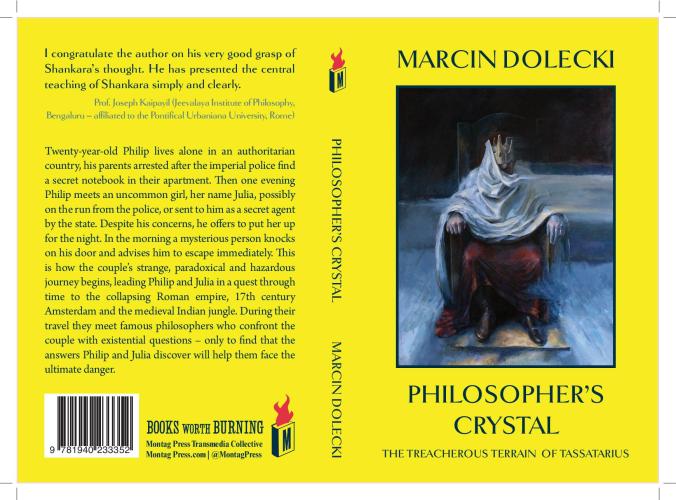 |
| (c) Mustang Press and Marcin Dolecki |
The Philosopher's Crystal is a philosophical fantasy that will pull you in, leaving you with the knowledge of several philosopher's basic ideals. Originally written in Polish, I read the translated English version and did not notice any discrepancies that would take away from the story.
Our story begins with a bit of background from the all mighty Tassatarius, emperor of a land that despises his rule. He likes to play games with those who work for him, and is quick to sentence those who displease him to death. With curfews, forced political beliefs, and little rights for his citizens, people have been trying to break free from his power, but no one has yet been successful.
The story flashes to our main character, Philip, whose parents have been arrested for owning books and believing in other political beliefs than those demonstrated by Emperor Tassatarius. Philip just turned twenty, the legal adult age for those who live in his land, and is worried that the emperor will come after him next. He unexpectedly meets a girl named Julia, who was oddly around his home just before curfew hit. Taking a chance and being kind, Philip allows Julia to stay the night, even though the two are strangers. From here, the plot picks up quickly, and the pair are thrown into a time-traveling plot that (oddly enough) transports them to different famous philosophers from throughout time! Traveling to Roman Africa, Amsterdam, and even an Indian jungle, Philip and Julia meet Augustine of Hippo, Descartes, and Shankara--philosophers who willingly share their wisdom and views. This book has an ending that is more reality-based than fantasy, so take the plot as is and have fun with it!
The author, Marcin Dolecki, is an admirer of brevity, or the "concise and exact use of words in writing or speech," as stated in his foreward to the Philosopher's Crystal. This is important to know, as it helps sets the tone and pacing of the story. Mr. Dolecki's writing is very to-the-point, which benefits the reader when it comes to our main characters encountering famous philosophers. The explanations of each philosopher's ideals is short and elaborated with questions and counter-points from both Philip and Julia. The writing demonstrates knowledge without the jargon you may hear from a lecture or read in textbooks. It felt a bit like going back to school, which I mean in the fondest way possible. If I were in a philosophy course, I would want to read the Philosopher's Crystal as either part of my coursework or as a supplement to understanding basic ideals. I hope to read more philosophy fantasy books from Mr. Dolecki in the future!
If you enjoy debating the ideas of life and philosophy in general, and enjoy a thrilling, fast-paced story, then this is the book for you!
 |
| Photo by Beata Wysokińska (2014) |
Marcin Dolecki is a philosopher (MA), chemist (MSc), and historian of chemistry (PhD).
He works as an educator at the Antonina Leśniewska Museum of Pharmacy (a division of the Museum of Warsaw). He gave lectures on the history of chemistry and philosophy at the Faculty of Chemistry of the University of Warsaw.
He is an enthusiast of cycling, and has visited Italy, Austria, Hungary, Slovenia, Romania, Lithuania, Latvia, Estonia, and Ukraine on his bike. He is also a big fan of ancient cultures, history of Ethiopia, and of vintage buses.








